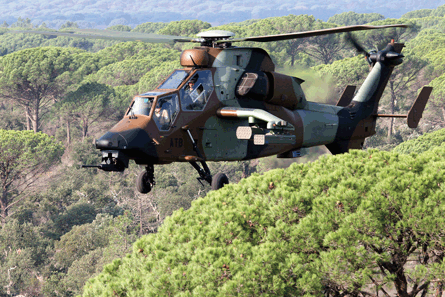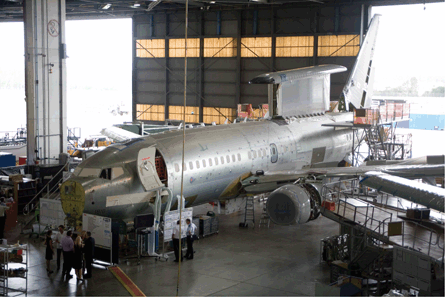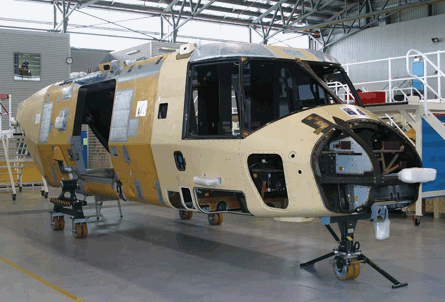Australian military aircraft procurement has been a sorry tale lately, with a number of projects cancelled as contractors have failed to deliver and schedules have gone awry.
When the current Labor government came to power in November 2007 it wasted little time in addressing what defence minister Joel Fitzgibbon described as the "long list of defence capability nightmares" that it had inherited from the previous government, compiling a "projects of concern" list.
Top of that list was the Kaman SH-2G(A) Super Seasprite project, which was cancelled in February 2008 after Australia had spent A$1 billion ($630 million) on a programme that was already running seven years late with no hope of achieving full functionality until at least 2010-11. Australia ordered 11 Super Seasprite helicopters for the navy in 1997. First deliveries were originally scheduled for 2001, but the programme was plagued with problems, primarily involving the integrated tactical avionics system. While Australia accepted nine helicopters, full functionality was never achieved, and the helicopters have been grounded since May 2006 after an automatic flight control system problem.
Australia now faces the prospect of spending another A$1 billion on a replacement helicopter and in the meantime plans to boost the capabilities of its ageing Sikorsky S-70B Seahawks. The Department of Defence says that project Air 9000 Phase 8 will provide "a modern, capable, multirole combat system" that will replace the current Seahawk fleet and the cancelled Super Seasprite. Australia is considering an acquisition of 27 helicopters, with a decision to be made by financial year 2017-18, with an in-service delivery date of 2017-19.
 |
|---|
© Australian Aerospace |
"Due to the desire for a military off-the-shelf solution and the requirement to interface with current surface units without major modification of either aircraft or ship, the Australian Aerospace/Eurocopter and Sikorsky/Lockheed Martin systems are the contenders at this stage," says the defence department.
PROJECTS OF CONCERN
Closely following the Super Seasprite on the projects of concern list was the army's tactical unmanned air vehicle acquisition, project JP129. Prime contractor Boeing Australia and partner Israel Aerospace Industries in late 2006 won the contract to supply a vehicle, based on IAI's I-View 250, with deliveries due in late 2009. But when the current government inherited the project it was already two years late and in September the contract was cancelled.
The A$6 million already spent by Australia on the project has been refunded by Boeing and Australia is seeking a new solution. "Analysis is being conducted to refine the capability required and information is being gathered on a UAV that could potentially meet these requirements," says the defence department.
Top of the projects of concern list now - and the project "that keeps me awake most at night", says parliamentary secretary for defence procurement Greg Combet - is the Boeing 737 Wedgetail airborne early warning and control programme. Wedgetail is running 38 months late following problems with its Northrop Grumman multirole electronically scanned array radar and BAE Systems Australia electronic support measures (ESM).
Australia, which is the launch customer, has six Wedgetails on order, four of which are being modified by Boeing Australia at the Royal Australian Air Force base at Amberley, Queensland in what is the largest and most complex commercial-to-military aircraft modification ever undertaken in Australia.
Although the DoD says a revised schedule has not been formally agreed with Boeing, the manufacturer is working towards an incremental delivery schedule whereby a training capability of two aircraft is due to be delivered by the end of this year, with full capability to follow in early 2010. "If Boeing meets these dates, the DoD anticipates that initial operational capability would be achieved by the end of 2011 and full operational capability by the end of 2012," it says.
 |
|---|
© Boeing |
The programme continues to suffer from problems with radar and ESM development and system integration. Wedgetail, however, is unlikely to face the same fate as the Super Seasprite and tactical UAV projects as it is considered too important a programme for Australia. Nonetheless, the project is causing the government a lot of concern, acknowledges Fitzgibbon, and as a result the spotlight is likely to remain on it.
One project that caused headaches - the Eurocopter/Australian Aerospace Tiger armed reconnaissance helicopter - is no longer giving concern. Australia ceased payments in June 2007 after the manufacturer failed to meet a contractual milestone relating to the training schedule and deliveries. The DoD says: "The project has made significant progress since the signing of a deed of agreement in April 2008 addressing the issues of dispute between the contractor and the Commonwealth."
Some 15 of the 22 Tigers on order for the Australian Army have now been accepted. Thirty air crew, 75 technicians and 67 ground crew have been trained,and more than 3,500h have been flown. In addition, 13 Lockheed Martin AGM-114 Hellfire missiles have been fired from the helicopter, each striking the target. The project is expected to achieve the initial operational test and evaluation milestone in September, with a deployable capability expected to follow next year.
Meanwhile, Australia's EADS KC-30A multirole tanker/transport is facing a six- to nine-month delay for the flight test and first delivery, but the full operational capability schedule is expected to be met. Delivery of the first Airbus A330-based KC-30 is expected in the fourth quarter of this year, says the DoD, subject to the successful completion of the second phase of the flight-test programme, which began in December, military certification and contractual acceptance of the military modifications. Initial operational capability is expected in the third quarter of next year. Some schedule recovery is expected, with the remaining aircraft to be modified by Qantas in Brisbane once the first aircraft has completed testing and contractual acceptance, says the DoD. As a result, the DoD expects full operational capability for both pod and boom refuelling and international air logistics services around mid-2011.
All is not doom and gloom, with some recent aviation procurement success stories among the delays and cancellations. The Boeing C-17 heavy airlift project, for example, was delivered on time and within budget, with four C-17s now in service.
The RAAF's Boeing F/A-18 Hornet upgrade programme has also gone well. Project Air 5376 HUG Phase 2.2 was completed late last year, with the final Hornet receiving an upgrade involving its radar system, avionics and electronics warfare suite. Phase 2.3, involving an interim electronic warfare upgrade, has been completed, on time and within budget.
Late last year also saw the delivery of the first Australian-assembled Australian Aerospace MRH90 multirole helicopter. Australia has ordered 46 MRH90s, with the first four French-manufactured helicopters based in Townsville and supporting training.
 |
|---|
© Australian Aerospace |
Canberra has sought to address weaknesses in the defence procurement system and processes as part of a wider focus on defence that will see the release of a new Defence White Paper,expected in April. The process was launched in February 2008 and is considered long overdue by many, with the country's current White Paper developed in the late 1990s. It will be the blueprint for Australia's future defence policy, setting out the government's plans for the size, capacity and shape for the next 20 years or more, says the government.
The White Paper will include the Air Combat Capability Review, which looks at Australia's air combat requirements up to 2045, including plans for the Lockheed Martin F-35 Joint Strike Fighter. The first part of the Air Combat Capability Review, looking at requirements up to 2015, was released last year and led to a government decision to stick with its predecessor's order for 24 F/A-18F Super Hornets to replace General Dynamics F-111s.
PROCUREMENT DECISIONS
With the new White Paper,Canberra is seeking to ensure it is in a position to make the right procurement decisions, by understanding the current security environment, Australia's strategic interests and future tasks and roles. "Unless we start from this base, future decisions about the Australian Defence Force's structure and key defence capabilities will be neither rigorous nor disciplined," says the government.
Beyond the White Paper, the government has launched reforms for the Defence Materiel Organisation (DMO), which is responsible for defence procurement, and the procurement process itself. Reforms are needed because of the scale and importance of defence procurement, strategic and economic trends, the poor performance of projects and the broader defence reform programme, says Combet.
He says the DMO is larger in terms of staff and budget than 10 of the 19 Australian government departments, with more than 7,000 employees and a budget this year of A$9.6 billion. It is managing more than 230 projects worth more than A$20 million and another 180 or so minor projects, he adds. In total, roughly A$100 billion-worth of projects are under the DMO's management. This responsibility is set to grow over the next 15 years, with more than 80% of the ADF's war-fighting assets to be replaced or upgraded.
In May 2008, the government launched a review of the country's defence procurement, which included looking at the progress of implementing reforms from the last such review - the 2003 Kinnaird Review.
The Mortimer Review, which released its findings in September, identified five principal areas of concern with the current defence procurement system. These were inadequate project management resources in the Capability Development Group, the inefficiency of the process leading to government approvals for new projects, DMO personnel shortages, delays due to inadequate industry capability and difficulties in the introduction of equipment into full service.
The report made 46 recommendations, the most contentious of which was that the DMO should be separated from the DoD and become an executive agency - a recommendation that was also made in the 2003 Kinnaird Review, but not implemented by the former government. Under the executive agency proposal, the DMO would have its own acquisition funding, would be headed by a chief executive with "significant private sector and commercial experience", and a new general manager commercial position created to implement a business-like focus throughout the organisation.
While the Kinnaird Review recommendations resulted in wide-ranging reform and improvement in the capability development process in the DoD and the DMO's acquisition process, recent problem projects such as JP129 "highlight that significant problems still exist within the defence procurement process", says the Mortimer Review. "This project [JP129] highlighted the continuing problems of scope creep and poor commercial practices within the current system, leading to the termination of the contract," it adds.
Many of the Mortimer report's recommendations are aimed at "making the DMO more business-like and imposing commercial discipline on the defence procurement and sustainment processes". They include a greater use of off-the-shelf solutions, assessing projects for their potential as public-private partnerships, changes to Cabinet processes to deliver a more efficient approval process and greater fiscal discipline.
The government is currently considering its response to the recommendations. The DoD says that consideration of the response is based on four key principles. The first is thatthe DoD must become more accountable to government and more transparent in managing its procurement budget. The second is that the DMO will strengthen its capacity to give government independent advice on the cost, risk, schedule and acquisition strategies for major capital equipment. The third calls for the DMO to implement a more business-like culture to deliver projects ontime, onbudget and to the DoD's requirements. The fourth is that the already strong procurement relationships within the DoD will be reinforced, for example through clarifying the authorities, roles and responsibilities of defence capability managers, the DMO and other internal DoD stakeholders, and by ensuring earlier engagement between DMO and the Capability Development Group.
The DoD declines to comment on the recommendation to separate the DMO, but the government is not opposed to such a move. "It is the outcomes in procurement rather than the institutional structure of the DMO that is important for the government," says Combet.
To keep a closer eye on some of the DMO's biggest and most challenging projects, the DMO and Australian National Audit Office has launched the Major Projects Report. The pilot report published last year details nine of the DMO's major projects - including the Tiger, Wedgetail, Hornet upgrade and C-17 programmes -highlighting progress against cost, schedule and capability performance.
Six from the DMO's top 30 projects will be added to the next Major Projects Report, although the DoD declines to name them. "The DMO is currently seeking formal approval for their inclusion in the 2008-9 report, which will provide project data information on 15 projects as at 30 June 2009," says the DoD.
 |
|---|
© Australian DoD |
In addition, the government recently announced the launch of the Defence Systems Integration Technical Advisory (DSI-TA), which is aimed at improving the management of complex defence projects. A joint venture between the DMO and the Defence Science and Technology Organisation, the DSI-TA is tasked with monitoring and assessing integration risks and providing advice to project teams and decision-makers.
It will also examine complex systems integration issues, perform systems engineering analysis and evaluate alternative capability solutions, says the government.
The government is keeping a close eye on the defence budget, appointing an independent audit of the defence budget in July. Canberra received the Pappas McKinsey audit report that will be incorporated into the Defence White Paper and will "provide a strong foundation for ongoing deep reform of defence management", it says.
It declines to comment on the audit, which is reported to recommend cutting spending by A$3 billion and reducing staff numbers at the DoD. Fitzgibbon says the independent audit will be "a key tool in our efforts to put the dysfunctional defence budget we've inherited back on track".
Source: Flight International



















